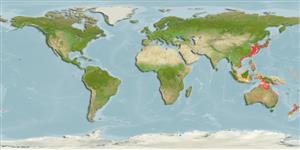Environment: milieu / climate zone / depth range / distribution range
экология
морской донно-пелагический; пределы глубины 20 - 100 m (Ref. 76777), usually ? - 100 m (Ref. 76777). Tropical
Northwest Pacific: East Asian Shelf to the Sea of Japan and Pacific coast of southern Japan (except Ryukyu and Ogasawara Is.), including the western part of Taiwan and South China Sea; questionable from Singapore.
Size / Вес / Возраст
Maturity: Lm ? range ? - ? cm
Max length : 20.1 cm SL самец/пол неопределен; (Ref. 76777)
Краткое описание
морфология | морфометрия
колючие лучи спинного плавника (общее число): 11; членистые (мягкие) лучи спинного плавника (общее число): 15-16; колючие лучи анального плавника 3; членистые (мягкие) лучи анального плавника: 9 - 10. This species is distinguished by the following characters: lower lip fleshy with dense cluster of short papillae and barbels anteriorly, on and behind chin with 10 pores, 4 anterioriormost pairs hidden by papillae, slightly scaly posteriorly (posterior abdominal part of angular of lower jaws; maxilla with small scales; 5-7 alternating whitish and dark-brown bands on head and body, the first (often indistinct) from just before eye to posterior of lower jaw, the second somewhat oblique, becoming wider posteriorly, from nape to between eye and pelvic-fin base, third one from base of 2nd and 3rd dorsal-fin spines to just behind pelvic-fin base, the fourth from 7th and 8th dorsal-fin spine base to just before 1st anal-fin spine, the fifth from 2nd and 3rd dorsal-fin soft ray base to anterior of anal-fin soft ray base, the sixth on caudal peduncle, and the seventh (often indistinct) on caudal-fin base; soft rayed portions of dorsal and anal fins are somewhat rounded posteriorly and slightly angulated posteriorly, respectively, spinous dorsal-fin and anal fin (until first anal-fin ray) membranes are dense black; membrane of soft dorsal- anal- (especially in juveniles and young) and caudal-fins somewhat yellowish in fresh specimens, a dense black margin posteriorly, about same width as pupil diameter (juveniles) or half of this width (adults); pelvic-fin tip not reaching to base of 1st anal-fin spine when depressed; pored lateral-line scales 44-47 (rarely 43 or 48); procumbent spine-like process (exposed tip of first pterygiophore) at origin of dorsal fin usually covered by predorsal scales (Ref. 76777).
Inhabits the sublittoral zone on sandy mud bottom (Ref. 11230). Most specimens were collected by bottom trawl in depths less than 100 m and smaller individuals (about 10.0 cm SL) by set nets at 20-50 m (Ref. 76777).
Life cycle and mating behavior
половая зрелость | размножение | нерест | икра | Fecundity | личинки
Iwatsuki, Y. and B.C. Russell, 2006. Revision of the genus Hapalogenys (Teleostei: Perciformes) with two new species from the Indo-West Pacific. Mem. Mus. Victoria 63(1):29-46. (Ref. 76777)
Статус Красного Списка МСОП (Ref. 130435)
Угроза для людей
Harmless
Использование человеком
дополнительная информация
ссылкиаквакультура (рыбоводство)особенности рыбоводствастепень растяжениягенетикаElectrophoresesнаследуемостьболезниобработкаNutrientsMass conversion
соавторыизображенияStamps, Coins Misc.звукиCiguateraскоростьтип плаванияжаберная областьOtolithsмозгзрение
инструменты
Специальные отчеты
Скачать в формате XML
ресурсы в Интернет
Estimates based on models
Preferred temperature (Ref.
123201): 9.7 - 25, mean 19 °C (based on 249 cells).
Phylogenetic diversity index (Ref.
82804): PD
50 = 0.5078 [Uniqueness, from 0.5 = low to 2.0 = high].
Bayesian length-weight: a=0.01862 (0.00830 - 0.04177), b=3.01 (2.81 - 3.21), in cm total length, based on LWR estimates for this (Sub)family-body shape (Ref.
93245).
Trophic level (Ref.
69278): 4.1 ±0.68 se; based on food items.
устойчивость к внешним воздействиям (Ref.
120179): высокий, минимальное время удвоения популяции до 15 месяцев (Preliminary K or Fecundity.).
Fishing Vulnerability (Ref.
59153): Low vulnerability (15 of 100).
